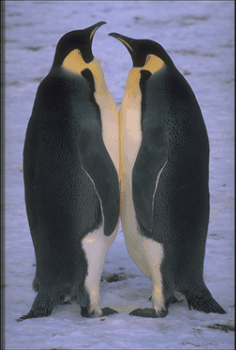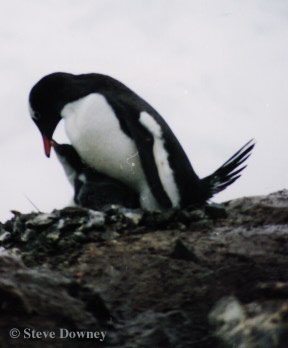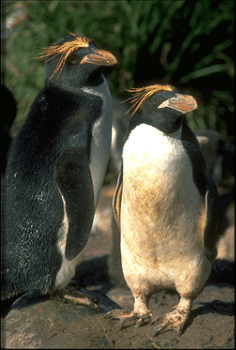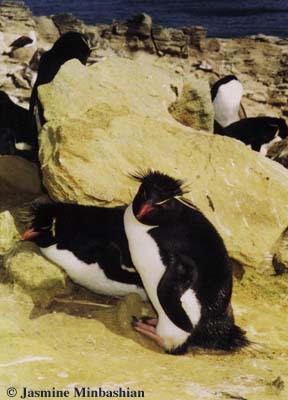 P
E N G U I N S
P
E N G U I N S
 P
E N G U I N S
P
E N G U I N S




Emperor Penguins live in the Antarctic and swim in the coldest sea in the world.
The Emperor Penguin is the largest penguin in the world--it's about three feet tall and weighs up to 100 pounds!
The Emperor Penguin can hold its breath for 15 to 20 minutes and lives an average of 15-20 years. It is a flightless bird. That means that it cannot fly. Instead of wings, it has small flippers that help it to swim very fast. . The Emperor Penguin eats lots of fish and krill in order to fatten up for its long trip to its mating grounds. Mating grounds are the places where animals go to have their babies.
One of the most remarkable things about the Emperor Penguin is its mating cycle. When it is time for breeding season, Emperor Penguins travel up to 60 miles inland. Sometimes they walk upright.. Sometimes they travel on their bellies.
After the Emperor Penguins get to its mating grounds they mate and the female lays a single egg. She then gives the egg to the father and leaves. The egg sits on top of the father's feet and under his brood flap. The brood flap is a loose piece of skin which covers the egg and holds it next to the father's body--kind of like an upside down kangaroo pouch. The father Emperor Penguin then incubates the egg.
![]() It is
very cold while the father Emperor Penguins incubate their eggs. They stand in a
tight huddle for 2-3 months straight! The fathers don't eat anything, they
just eat a little snow for moisture. They lose almost half of their body weight.
Once in a while, the fathers will reach down and turn their eggs over to make
sure that they don't freeze. Because the father Emperor Penguins stand so close
together, they conserve half of the body heat that they would lose if they
didn't have others around.
It is
very cold while the father Emperor Penguins incubate their eggs. They stand in a
tight huddle for 2-3 months straight! The fathers don't eat anything, they
just eat a little snow for moisture. They lose almost half of their body weight.
Once in a while, the fathers will reach down and turn their eggs over to make
sure that they don't freeze. Because the father Emperor Penguins stand so close
together, they conserve half of the body heat that they would lose if they
didn't have others around.
![]() When
the chicks finally hatch they are hungry. Their father's then regurgitate a
white secretion and feed it to the chicks.
When
the chicks finally hatch they are hungry. Their father's then regurgitate a
white secretion and feed it to the chicks.
![]() After
the chicks are born, their mothers come back to take care of them. At first, the
fathers don't want to give up the babies, but they eventually do. They transfer
the chick from the feet of the father Emperor Penguin to the feet of the mother
Emperor Penguin. They have to be very careful when they transfer the chick,
because if he falls on the ground for more than a few minutes, he will die.
After the mother has the chick, the father Emperor Penguin hurries off to get
himself something to eat. Can you imagine going for four months without eating?
People can't do that. We would starve to death.
After
the chicks are born, their mothers come back to take care of them. At first, the
fathers don't want to give up the babies, but they eventually do. They transfer
the chick from the feet of the father Emperor Penguin to the feet of the mother
Emperor Penguin. They have to be very careful when they transfer the chick,
because if he falls on the ground for more than a few minutes, he will die.
After the mother has the chick, the father Emperor Penguin hurries off to get
himself something to eat. Can you imagine going for four months without eating?
People can't do that. We would starve to death.


![]() Adelie penguins have to defend their nests from other penguins who try to steal
pebbles, stones, and other nest building materials. They don't drink water but
eat snow. They have a gland in their nose that takes the salt out of the ocean
water that they swallow when catching fish and eating fish while in the water.
Adelie penguins have to defend their nests from other penguins who try to steal
pebbles, stones, and other nest building materials. They don't drink water but
eat snow. They have a gland in their nose that takes the salt out of the ocean
water that they swallow when catching fish and eating fish while in the water.











![]() Gentoo, meaning "turban", refers to the whitish markings behind the
eyes of this species. Gentoos range in size from 27 inches highand 12 pounds in the south to 30 inches high and
13.5 pounds in the north. The 60 degree parallel marks the general
separation point between the Gentoos' north and south ranges.
Gentoo, meaning "turban", refers to the whitish markings behind the
eyes of this species. Gentoos range in size from 27 inches highand 12 pounds in the south to 30 inches high and
13.5 pounds in the north. The 60 degree parallel marks the general
separation point between the Gentoos' north and south ranges.
![]() Most of their colonies run along the Antarctic Peninsula. Unlike the Adélies
and Chinstraps, Gentoos stay with their mates throughout the year. A mating pair
may reuse a previous site, although they typically change from year to the next.
Gentoos commonly locate their nesting sites inland. To ease their burden walking
to and from the sea, Gentoos establish a common path for everyone. This
continuous use wears down the path and makes it easier to use.
Most of their colonies run along the Antarctic Peninsula. Unlike the Adélies
and Chinstraps, Gentoos stay with their mates throughout the year. A mating pair
may reuse a previous site, although they typically change from year to the next.
Gentoos commonly locate their nesting sites inland. To ease their burden walking
to and from the sea, Gentoos establish a common path for everyone. This
continuous use wears down the path and makes it easier to use.
![]() Gentoo chicks stay with the parents for about eight weeks. During their 9th and
10th weeks, chick return home at night to be fed. Should the mating pair lose
their first clutch of eggs, a second set is laid if earlier enough in the
season.
Gentoo chicks stay with the parents for about eight weeks. During their 9th and
10th weeks, chick return home at night to be fed. Should the mating pair lose
their first clutch of eggs, a second set is laid if earlier enough in the
season.
![]()

![]() Rockhoppers are part of a family of penguins called the crested penguins because
of the brightly colored feathers on their heads. These bright feathers look like
long eyebrows. Rockhoppers are the smallest of the crested penguins.
Rockhoppers are part of a family of penguins called the crested penguins because
of the brightly colored feathers on their heads. These bright feathers look like
long eyebrows. Rockhoppers are the smallest of the crested penguins.

![]() They eat squid, krill and other small fish.
They eat squid, krill and other small fish.
TOP
Slideshow